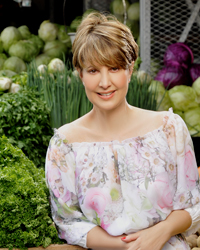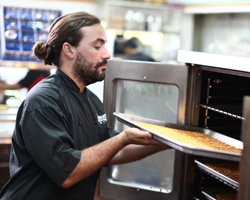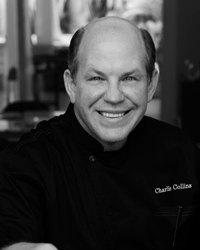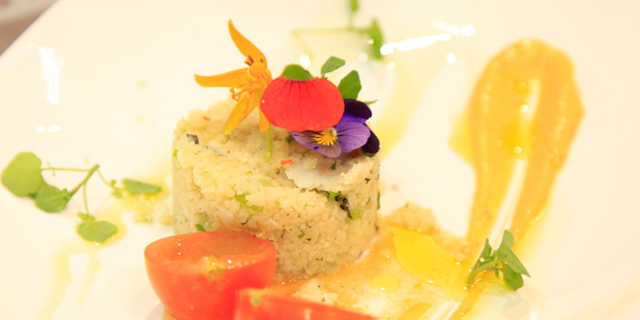Interest in Panama is at an all-time high. Like Costa Rica before it, Panama’s natural resources and rich, multi-ethnic history are turning it into a coveted destination. And foodies and gourmands are beginning to flock here, particularly during late August. That’s when Panamá Gastronómica, the country’s premier food festival, brings together native chefs and fans from around Central and South America.
Panamá Gastronómica founder and president, Elena Hernández, who also runs a cooking school, Academia de Artes Culinarias, debuted the festival in 2009, and it’s grown phenomenally since. “More than a three-day event, Panamá Gastronómica is now a brand that looks to promote and elevate Panama’s gastronomy, and put us on the map of culinary destinations,” Hernández says. “We have consistently grown since our first year, moved our venue to accommodate more expo space and activities, [and] little by little [have] been recognized internationally. We are getting there, I think.”
Indeed, getting there has been a lot of the fun, and Hernández has been joined in her efforts by local icons and internationally acclaimed chefs.
“I admire many chefs in my country, most importantly those who are working with local ingredients and taking Panamanian cuisine to other levels,” she notes. “I can name Cuquita Arias de Calvo, who is one of the pioneers of New Panamanian Cuisine and written several books on the topic. Mario Castrellón is a young chef whose Maito tops the lists of favorite restaurants in Panama City, and Charlie Collins is a well-respected catererer in Panama who specializes in New Panamanian Cuisine and who, along with Cuquita, has been an inspiration to many young cooks.”
But what exactly is New Panamanian Cuisine?
Find out next!
[pagebreak]Originally settled in the early 1500s by the Spanish, Panama is, by most accounts, a Latin country. A typical day’s menu there: tortillas and eggs for breakfast, ceviche for lunch, sancocho for dinner with a sweet finish of flan. But if Panamanian food could talk, it would speak in dialects of Chinese, African, French, and Native Indian, courtesy of the populations that have emigrated there (either willingly or unwillingly) to work or take ownership of the Panama Canal. And the high-end chefs who have made names for themselves, in both Panama City and in the resorts along both coasts, are well aware of the depth and breadth of the natural cornucopia as well as the closely intertwined global influences they have at their disposal.
Although the definition changes depending on who’s asked, most professionals concur with Hernández. “Panamanian cuisine is the result of the many cultural influences throughout our history… cuisines of the immigrants who came to Panama City to work in the construction of the Panama Canal.” The base of the fare, she says, is built on native ingredients such as a variety of fish, seafood, coconut, salted codfish, ginger, curry, plantains, and other root vegetables. Other influences can be found in the dishes. Then there’s
Cookbook author, television personality, and local chef Cuquita Arias De Calvo (right) agrees that “Panamanian cuisine is different from the rest of Latin America because it is exposed to a world of influences via the Panama Canal.” Long considered the “Martha Stewart” of Panama, and a true advocate for both the country and its cuisine, Arias resides over SalSiPuedes, named after the marketplace that sells Chinese and Panamanian crafts and goods. Located in the boutique hotel Bristol Panama in Panama City, SalSiPuedes is considered one of the more avant-garde culinary properties in town, with her menu listing delicacies including fried wontons filled with green plantain, chorizo and mango; beef tenderloin with tri-colored peppercorns, passion fruit sauce and pigeon pea mash; or a prawn coconut milk-curry heightened with cranberries and cashew chutney.
Rightly so, Arias De Calvo refers to her cuisine as “evolved… based on the principle of traditional Panamanian cuisine but elevating often-overlooked products and add creativity and sophistication. I always love to create unexpected ways of using traditional products and long-forgotten ones to surprise our guests,” she says. Indeed, her sumptuous creations include daily fresh seafood from both the Atlantic and the Pacific oceans – Panama is lucky enough to have access to two coasts — but they contain delicately plated items that can be curious to the less well-informed. Salads, for instance, might have garnishes of dim sum. Even familiar desserts, such as arroz con leche or flan, take on innovative life when Arias De Calvo pairs them with essences of coffee, vanilla, lemon and herbs.
Diners new to Panama or SalSiPuedes don’t remain uninitiated for long. As Arias De Calvo notes, the soul of the Panamanian is a welcoming one. “The Panamanian is cheerful and friendly and readily accepts the influences of other cultures, blending it with [her] own. The Spanish, Colombian, Caribbean, Afro-Caribbean, and Chinese influences are united with our generations of culinary roots, merging together to create a mix of flavors that comprise our unique cuisine.”
Next, more on the multi-dimensional Panamanian cuisine…
[pagebreak]The basis of that unique cuisine, the local flora and fauna, is similar to neighboring Afro-Antillean nations: gandules (pigeon peas), avocado, coconut, tamarind, citrus, yucca, corn, plantains. Chef Patrick Maurin at Tejas Restaurant & Bar at The Trump Ocean Club International Hotel & Tower Panama, also in Panama City, considers such ingredients, especially plantains, as not only native but astonishingly versatile. “Plantains can be used for cooking at any stage of ripeness, boiled, steamed, baked, grilled, fried, mash, flour, side, appetizer, snack, or dessert. And you can find them all year round,” he marvels. Plantains so impress the chef, who confesses he’s not a fan of fried food, that he’ll even make an exception by eating patacones, green plantains that are pounded and fried.
However, it’s the country’s external gastronomic manipulations that intrigue Maurin the most. To that end, his own brand stays true to his classic French training, spiked with Asian flavors and what he calls “inspiration from culinary capitals like London, New York, and Singapore. I force myself not to follow what chefs are doing in the city where I work.” Instead, he learns from and adapts those trends to the basics of Panamanian cuisine, which is, “lots of great product from the sea. Fresh, not farmed, and received daily,” he notes. To that end, he’s concocted such dishes as an appetizer of creamy avocado cannelloni with shrimp-cilantro salad, tomato bread crumbs and warm corn cream and a main course of sous vide mahi-mahi with cardamom-ñame puree and green sauce. Desserts include an irresistible fried cheesecake topped with mango-passion fruit chutney and garnished with Gran Marnier ice cream.
The eternal frontier town, Panama City offers the type of fusion fare that Arias De Calvo and Maurin are cooking at a variety of hotel and independent restaurants. As befitting the potential of both dishes and chefs, many of these are located in World Heritage site Casco Viejo, or Old Town, the historical district also known as Casco Antiguo or San Felipe. There, Colonial-era buildings are being revamped into boutique lodgings with hip restaurants and bars. Tántalo, known for its rooftop bar and swank Tántalo Kitchen, is one such 
Mario Castrellón’s (left) Maito is another venue where New Panamian Cuisine reigns supreme. Trained in classic Spanish technique, Castrellón mixes a bit of alta cucina method with fresh vegetables and herbs from the restaurant’s on-site garden, and voila: dishes such as cappuccino of tomato soup with goat cheese foam; crisp plantain wafers topped with grilled jumbo shrimp and tropical fruit salsa; wood oven-roasted salmon topped with Dijon crumbs and partnered with tomato confit; and baby-back ribs caramelized with honey, lemongrass and passion fruit barbecue sauce. Sit in the garden under rustling mango trees (though watch out for “the drop” during season!) and savor a selection from the international wine list along with the accomplished fare.
You can even find the new brand of Panamanian fare at one of the city’s oldest tourist attractions – overlooking the locks of the Canal at Miraflores restaurant. Known for its tiraditos and ceviches, the chefs at Miraflores take pride in their artful arrangements of luxe ingredients, such as lightly marinated shrimp composed with leaves of Brussels sprouts and a dollop of caviar.
Next, a look at resort fare…
[pagebreak]The resorts outside the city also feature restaurants where New Panamanian cuisine is a draw. This is due in large part to veteran Charlie 
Likewise, while you might not find grazing cattle and trout-filled streams, you’ll only find the freshest of everything at the JW Marriott Panama Golf & Beach resort. Executive Chef Jose Rodriguez, a New York City native who overseas the resort’s five restaurants, is continually amazed by the quality at hand. “It is said that the word Panama, or Bannaba, means ‘abundance of fish,’ which gives you the heart of the native ingredient,” he says. “The ability to work with such great ingredients and delicate product, mixed with the abundance of exotic fruits, and have them at my footsteps as I wake up every morning is a blessing in itself. Being from New York and remembering going to the Fulton Fish Market at 5 am to find every species of fish and wondering where they were caught to now watching the fisherman pull it out of the sea is amazing. Panama is the perfect country to put together memorable local dining experiences at the dinner table.”
Still, if you want to try it all at once, Panama Gastronómica is the event to tailor your trip around. This year, Hernández was delighted to find that the festival broke its record of attendees — more than 14,500 in three days. In addition, “We managed to host an incredible lineup of international presenters, and put on the largest culinary show ever to take place in the country: demonstrations on three different stages, a food truck festival, a craft beer fest, more than 40 food spots throughout the event, ‘Art of the Table’ exhibits and an international cooking school competition, [featuring] fifteen cooking schools from Latin America.”
If that sounds like a pleasant way to exhaust your palate and learn the ins and outs of New Panamanian Cuisine at the same time, Hernández wants you to know that she’s not done yet. “We always look for ways to improve and create new activities so people have new surprises every year. We’re still wrapping up this year’s event and starting to plan the next. We will keep you posted.”


![Making Mealtime Matter with La Familia: Easy Sofrito [Video]](https://thelatinkitchen.com/wp-content/uploads/2015/10/sofrito-shutterstock__0-500x383.jpg)
![Easy Latin Smoothies: Goji Berry Smoothie [Video]](https://thelatinkitchen.com/wp-content/uploads/2015/12/goji_berry-shutterstock_-500x383.jpg)
















![Fun and Fast Recipes: Fiesta Cabbage Salad [Video]](https://thelatinkitchen.com/wp-content/uploads/2015/11/fiesta_cabbage_slaw-shutterstock_-500x383.jpg)









